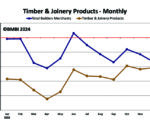Double digit growth for housing and commercial signals increasing construction confidence
 Healthy growth in the residential and commercial sectors during the first quarter of 2014 shows UK construction confidence is increasing, according to the latest figures from industry analysts Glenigan. The Glenigan Index, which covers the value of projects starting on site from January to March, is 15% higher than a year ago – propelled by double digit growth across the residential, non-residential and civil engineering sectors.
Healthy growth in the residential and commercial sectors during the first quarter of 2014 shows UK construction confidence is increasing, according to the latest figures from industry analysts Glenigan. The Glenigan Index, which covers the value of projects starting on site from January to March, is 15% higher than a year ago – propelled by double digit growth across the residential, non-residential and civil engineering sectors.
House building continued to rise in the three months to March, with the underlying value of private housing project starts up by 29%. This outweighed an 8% decline in the value of social housing starts. Commercial activity also remains buoyant, with the underlying value of office project starts rising by 34%, retail by 28% and hotel and leisure by 15%.
In contrast, social housing, education, health and community & amenity starts all declined – indicating a clear divide between the private and public sectors. However this was offset by growth across the rest of the industry. Commenting on these latest figures, Allan Wilén, Economics Director at Glenigan, said: “Increasingly, we are seeing improved business sentiment translating into real investment across the economy. The positive project data within the commercial sectors in particular shows that firms and developers are more confident putting money into new construction. Private housing will continue to be a key driver of increasing construction activity, as evidenced by strong project starts in the first quarter of 2014.
“The sector’s longer term fortunes were given a further boost in the government’s recent Budget, particularly with the extension of the Help to Buy equity scheme which will now run to 2020. The move provides additional certainty to house builders to bring forward sites for development and is projected to help a further 120,000 householders purchase a home.”
The sectors most dependent on public funding have continued to perform less well. The value of health sector project starts fell by 14%, while community & amenity construction declined by 21%. A return to growth looks unlikely as government capital expenditure remains focused towards infrastructure investment.
Having been the strongest growing market sector in 2013, the value of education starts fell in the first quarter of 2014. However the prospects for the sector remain positive, with government funding streams such as the Priority School Building Programme (PSBP) likely to have an increased impact on the ground further into 2014.
The regional picture is one of rising activity across southern UK regions, with the east of England continuing to see particularly fast growth. Starts also improved in the East Midlands, but fell back in the West Midlands for the third successive month.Further north, starts in the North West were up 49% compared to a year ago, but starts fell back in the North East and Yorkshire and the Humber.
Across the rest of the UK, the first quarter of 2014 was largely positive following contrasting fortunes last year. Activity in Northern Ireland picked up strongly in 2013, as the Irish economy and housing market improved, and starts saw further growth in the first quarter of 2014. Growth in Scotland in 2013 was moderate but has now begun to accelerate, while activity in Wales continues to recover quickly from a tough 2013.
The monthly Glenigan Index is based on extensive research of every construction project starting in the UK over the previous three-month period, providing an indicator of developing activity and future output in the industry.











